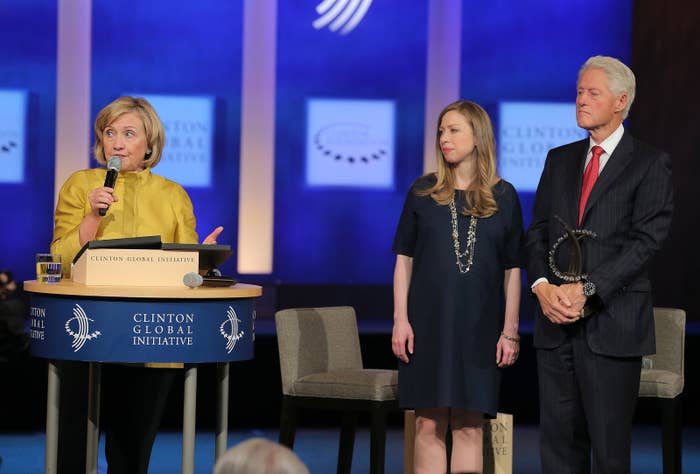
She hasn’t returned to the Clinton Foundation in a formal capacity. But nine months after an election that left the charity smaller in size, scope, and funding, Hillary Clinton is stepping into a new supporting role — to raise money on behalf of the organization.
The fundraising plans, confirmed by foundation spokesperson Craig Minassian, bring the former candidate back into a nonprofit still adjusting to new and uncertain terrain, with Bill Clinton, 71, serving in a new role as chair, and Chelsea Clinton, 37, as vice chair.
The father and daughter, along with senior staff, spent much of last spring initiating a massive effort to scale down the 15-year-old global operation: Where funding might present a conflict of interest, those programs were spun off, shuttered, or absorbed by other nonprofits. The idea, to prepare for a possible move to Washington, led to a different reality: to retrenchment; to big, open questions about the direction of the work; and to frequent talk about the future. “I want to send a clear signal that we’re serious about continuing our work,” the former president told the Miami Herald this spring.
Funding has been a particular focus after revenue declined in 2016. In part, that was natural: Bill and Chelsea Clinton spent the year pulled between the trail and fundraising for the campaign, while the foundation became the target of attack ads, and self-imposed donor limits meant it could not solicit foreign grants. (A year later, the foundation is now applying for such grants again.) But more broadly, financial longevity at the foundation is also a source of discussion among longtime donors now that the Clintons have left electoral politics. Another lasting challenge will be the end of the annual Clinton Global Initiative event, a gathering that drew celebrities, politicians, foreign leaders, and corporate executives, and served as the foundation’s biggest platform.
Hillary Clinton’s renewed fundraising presence came without much notice earlier this month: At the bottom of an email from the Clinton Foundation, above a bright orange “DONATE” button, her name appeared in the signature line for the first time since she stepped down from the foundation to launch her campaign in the spring of 2015.
“Your support means so much to Bill (and to me),” she wrote, stressing what she cast as the promise of the future in spite of damage from an election of “unprecedented, ugly, and misleading or outright false attacks ... which incredibly still continue today.”
Whether Hillary Clinton, 69, will return to an official role at the foundation, where she served on the board after leaving the State Department in 2013, remains uncertain.
“We are not there yet even remotely now,” spokesperson Nick Merrill told the New York Times in February. Six months later, he and Minassian only confirmed that while Clinton holds no official role, she will help with fundraising, from appearances at foundation events to digital campaigns. (Her email this month raised more than any individual foundation fundraising email in the last five years, according to Minassian.)
In her two years at the foundation, she launched an early childhood development program, and partnered with Chelsea Clinton on a campaign to protect elephants (CGI Elephant Action Network) and a data study on women and girls (“No Ceilings”). After the election, Hillary Clinton also cofounded a political group, Onward Together, to fund and support a coalition of grassroots activist-led organizations on the left.
“Secretary Clinton strongly believes in the foundation, and we're grateful that she will continue to support its critical, life-changing work, including fundraising on the foundation’s behalf,” Minassian said in a statement
The foundation, formed in 1997 as a fundraising vehicle for the Clinton Presidential Library in Little Rock, Arkansas, relaunched in 2001 as the basis for Bill Clinton's sprawling enterprise of programs across the world, powered by partnerships between businesses, governments, and nonprofits. The model made the Arkansas Democrat a pioneer in philanthropic circles for his work with public-private partnerships. The money and power around that model, meanwhile, made his work a long-running source of scrutiny, raising questions about influence, transparency, and the interests of foreign and corporate donors.
On the other side of 2016, officials are still looking at more basic questions, like what kinds of program to start, what kinds to expand, and to what scale.
Because of the changes made last year, much of the foundation’s work is now domestic-based, such as one three-year program, now growing, to provide schools with drugs to counter opioid overdoses. The flagship Clinton Global Initiative event survives in miniature, with smaller gatherings and forums (most recent: Caribbean leaders on local women’s health care). The yearly "commitments" that have been made at CGI also continue and some continue to grow, along with an offshoot for college students, the Clinton Global Initiative University.
Without the annual event, however, there is already a replacement on the calendar: Michael Bloomberg, the billionaire former mayor of New York City, will host CEOs and government leaders, including Bill Clinton, at the first Bloomberg Global Business Forum — held around the same time that the CGI used to convene in the Sheraton Times Square.
The scale-down, Bill Clinton told staffers last year, “is like a root canal for me.”
